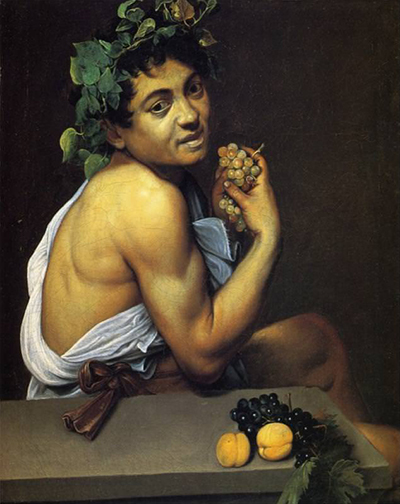Young Sick Bacchus, created between 1593 and 1594, is an oil-on-canvas painting that was produced by Michelangelo Mersisi da Caravaggio during the early part of his career.
Caravaggio, born in Milan and a student of Simone Peterzano, had moved to Rome in the hope of establishing a reputation for himself as an artist and had found employment as a painter in Giuseppe Cesari's workshop.
An illness, thought by some to be Malaria, incapacitated the young artist for a period of six months and it is believed that he painted a self-portrait at this time with the use of a mirror. The resultant painting, in which its subject is depicted as a Roman deity, hangs in the Galleria Borghese in Rome.
Bacchus, along with his Greek counterpart Dionysus, was associated with viticulture and sometimes appeared in the artworks of Classical antiquity with a cluster of grapes in his hand.
Caravaggio, whose tendency towards alcohol-fuelled violence echoed the Bacchanalian excesses that had once plagued the ancient Roman Republic, may have been referring to his own lifestyle choices when he made the decision to paint himself in the guise of the wine god.
The painter's desire to find patrons could have motivated him to combine elements of portrait and still-life within one painting, present in the form of the youthful deity as well as in the grapes and peaches, in order to demonstrate his talents in those fields to potential buyers.
The wine god, his skin jaundiced and his lips pale, sits at a grey table with his elbow resting on the top surface and wears a white toga that reveals his upper back and a muscular arm. The light, travelling from left to right, illuminates the exposed portions of his back and is reflected by the grape skins.
The dark background, the interaction of light with solid objects and the casting of short shadows where the light is obstructed creates the illusion of three-dimensional forms existing within the painting. This technique, known as Chiaroscuro, had been an important aspect of painting since Leonardo da Vinci developed it in the fifteenth century.
Caravaggio, having created several still-life artworks of fruit and flowers in Cesari's workshop, included two grape varieties within the painting. The grapes held in the youth's hand, similar in appearance to white Muscat grapes from which amber wine is made, are shades of orange and yellow.
A shriveled grape, the lines of its sagging skin reflecting the light, indicates that these grapes could soon produce the concentrated juice that was fermented into sweet wine.
The grapes on the surface top, near the peaches and vine leaves, are dark purple and would create red wine if macerated. Attention to detail, such as the solitary shriveled grape, was characteristic of the Lombard school that had influenced Caravaggio during his training.




